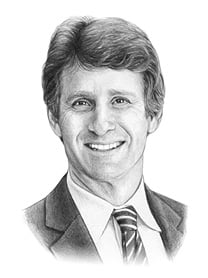A President Who Championed American Universities

A President Who Championed American Universities
Trump’s attacks on higher education come 75 years after Lyndon B. Johnson set out to transform the sector.
People gather around the John Harvard statue on Harvard University’s campus in Cambridge, Massachussetts, on April 15. Joseph Prezioso/AFP/Getty Images
In 1965, the president of the United States believed in higher education. After defeating Sen. Barry Goldwater in a landslide victory, one of Lyndon Johnson’s central goals was to move legislation through Congress that would make it easier for Americans to afford the cost of attending a college or university. Johnson believed that providing everyone with the best possible education was as vital as social safety net programs.
In 2025, the times have changed. President Donald Trump has turned federal funding for higher education into a bludgeon.
In 1965, the president of the United States believed in higher education. After defeating Sen. Barry Goldwater in a landslide victory, one of Lyndon Johnson’s central goals was to move legislation through Congress that would make it easier for Americans to afford the cost of attending a college or university. Johnson believed that providing everyone with the best possible education was as vital as social safety net programs.
In 2025, the times have changed. President Donald Trump has turned federal funding for higher education into a bludgeon.
He is attempting to drain universities of vital research funds that sustain scholarship on international problems such as Alzheimer’s and HIV/AIDS. His administration has imposed draconian terms on several major universities, insisting that it won’t negotiate over funding unless the schools accept dramatic expansions of federal control over departments, curricula, and admissions. Congressional Republicans are contemplating a massive endowment tax that would severely cut into the money select universities have available to finance their operations. More is certainly coming.
Next in his crosshairs will be federal student loans. The student loan program has been in a state of perpetual uncertainty since the COVID pandemic. Both President Trump, during his first administration, and President Joe Biden instituted forgiveness programs and delayed payments to help a generation get through the economic shutdowns and turmoil of the era. In 2023, the Supreme Court overturned a Biden program that would have eliminated federal loans up to $20,000, which would have helped roughly 40 million people. Recently, the Department of Education announced that it would begin collecting on defaulted student loans. Those in default will be referred to debt collectors, or put into repayment plans which automatically take funds from their earnings.
The president has created a number of other challenges to college students and graduates, including issuing an executive order to dissolve the Department of Education, the agency that would ordinarily help people navigate these obligations and the changes to the law.
Meanwhile, Trump and the congressional GOP might eliminate a number of important programs. Trump has already targeted Public Service Loan Forgiveness, a program put into place by President George W. Bush in 2007 that provides debt relief to graduates who go into the public sector. President Biden’s SAVE program and various loan forgiveness programs might also be on the chopping block.
While there are certainly enormous problems with the federal student loan program, there is little reason to believe that the administration has any plans to undertake good-faith reform. The overall goal, the evidence strongly suggests, is to dramatically curtail and weaken a higher education program that has been at the heart of the economy and society since the end of World War II.
Back in 1965, President Lyndon Johnson had a very different vision for America. Johnson believed in the power of education and insisted that the federal government needed to play an important role in ensuring that every citizen who wanted to learn could do so. As part of his broader Great Society plan, he envisioned government support as a means to help citizens become self-sufficient.
Johnson has said his belief in education was forged when he took a break from his studies at Southwest Texas State Teachers College to teach poor Mexican American children in Cotulla, Texas, between 1928 and 1929. Through the students in his classroom, Johnson saw firsthand how much education meant to students who faced dire poverty and discrimination. “I shall never forget the faces of the boys and the girls in that little Welhausen Mexican School,” Johnson while signing the Higher Education Act in 1965, “and I remember even yet the pain of realizing and knowing then that college was closed to practically every one of those children because they were too poor.”
During the 1940s and 1950s, when serving in the House of Representatives and then as Senate majority leader, Johnson led Democrats as they worked with Presidents Franklin Roosevelt (Democrat), Harry Truman (Democrat), and Dwight Eisenhower (Republican) to expand federal investments in universities—from sending students through the G.I. Bill (1944) to pouring money into research through the National Defense Education Act (1958)—stemming from the belief that knowledge was integral to economic growth and maintaining a U.S. advantage over the Soviet Union. In these decades, argues the historian Christopher Loss in Between Citizens and the State, government and education embraced collaboration as a modus operandi—rooted in the Land Grant Act of 1862 (the Morrill Act), which directed revenue made through the sale of federal lands to the establishment of land-grant colleges.
Thus, it did not come as a surprise that Johnson made education a top priority in his Great Society when he was president. The Elementary and Secondary Education Act of 1965 provided federal support to schools with many children from low-income communities. Never content to stop with one bill, Johnson wanted more. The president turned his attention to the next stage of the education process: college. With the Baby Boomers swelling high schools, demand to spend four years on a campus kept growing.
In 1965, seeking to quickly spend the political capital he had accumulated from beating Goldwater so decisively in the election, Johnson worked with the Democratic Congress to tackle higher education, continuing the work John F. Kennedy had begun.
The chief sponsors of his higher education legislation were Rep. Edith Green, a former schoolteacher (often remembered as the “mother of higher education”), Adam Clayton Powell, and Sen. Wayne Morse. Congress passed the legislation with strong bipartisan support in both chambers. Because of the decentralized nature of the higher education system, legislators from both parties and from every region had a direct incentive to support the measure.
The Higher Education Act of 1965 was a landmark achievement. The legislation set up an elaborate system of low-interest student loans. Private banks would provide the funds while the federal government would subsidize and insure them. A new work-study program was created to enable part-time students to work for their education. The bill also directed federal money to historically Black colleges and universities (HBCUs). A National Teachers Corps would create incentives to attract teachers within poor communities, while grants would support libraries and other academic facilities.
Upon signing the legislation, Johnson promised that the Higher Education Act would “swing open a new door for the young people of America.” In response to conservative critics who said this would threaten federal control of schools, the president promised that the money did not come with any strings attached. “The federal government has neither the wish nor the power to dictate education,” he said. This was an investment in the United States, not some sort of gift or handout.
Just five years after Johnson signed the law, Robert Dallek noted in Flawed Giant that one out of four college students was a beneficiary of financial aid under HEA.
In 1972, Congress passed amendments to Johnson’s higher education legislation that increased the level of student aid and created the Basic Educational Opportunity Grant (later renamed Pell Grant) for low-income students. Six years later, Congress launched the Middle Income Student Assistance Act, which eliminated the income cap for federally subsidized student loans. In 1998, Congress established the Gaining Early Awareness and Readiness for Undergraduate Programs, which prepared low-income high school students for succeeding in college, while in 2008, it added measures that attempted to render costs for families more transparent.
According to historian Joshua Zeitz in Building the Great Society, federal annual expenditures on postsecondary students rose by 10,000 percent in inflation-adjusted dollars between the time of Kennedy’s assassination in 1963 and 2010. Roughly 2 million Americans receive a bachelor’s degree every year. The kinds of young adults who now attend our cherished colleges and universities span many social, economic, and cultural backgrounds, just as Johnson had hoped when thinking about the kids in the school where he once taught.
In 2010, the Health Care and Education Reconciliation Act ended 35 years of the government subsidizing private lenders, and the new Direct Loan Program allowed the federal government to provide loans directly with an eye toward achieving savings.
After initially reducing costs, the federal loan program has struggled with many problems. Critics have argued that increased loans have fueled rising tuition rates. Adults are saddled with enormously challenging obligations at a time when they are already struggling with housing, child-rearing, health care, and other costs. The constant changes with requirements have also left former students uncertain about what they need to do or what the new rules even are, none of which has been easy with diminishing numbers of government workers to assist.
The convergence of the federal student loan program facing serious challenges that require reform and make it vulnerable, and an administration hostile to higher education puts the entire federal commitment at grave risk. A president who sees every federal dollar as leverage to gain control over educational institutions won’t be able to resist this substantial pool of money.
If the war on education continues, the president’s second term will culminate with universities and colleges struggling to maintain basic research programs, course catalogs, and student financial support. Federal assistance for students who need it will be dramatically lower, if it exists at all, while most institutions of higher education will have to raise tuition to make up for lost money. They will concentrate on students of means who can pay for a full ride. Banks with a history of taking advantage of those in need will have more opportunities to exploit citizens seeking to learn. A high-endowment tax will eat away at the funds that many select universities have used to pay for the tuition of middle and working-class Americans who otherwise could not afford attendance.
Higher education institutions have been a crown jewel of America for over a century. Johnson’s legislative legacy expanded access to these institutions and transformed the opportunities available to many generations of students. Students and faculty from around the world flocked to the nation’s campuses and obtained the chance to learn, grow, and enter into intellectual communities that would serve as an important foundation for their personal and professional lives.
The current trajectory is devastating. It would leave the United States impoverished, weakening its citizenry, enfeebling its economy, and making the country less secure than it has been since the start of the Cold War.
This post is part of FP’s ongoing coverage of the Trump administration. Follow along here.
Julian E. Zelizer is a columnist at Foreign Policy and a professor of history and public affairs at Princeton University. He is the author of The Long View, a newsletter putting the news in perspective. X: @julianzelizer
More from Foreign Policy
-

An illustration shows a line of large shopping carts facing down a small Donald Trump figure holding two shopping bags. The stars of China’s flag are in the upper left corner. Why Beijing Thinks It Can Beat Trump
China’s elites have a new confidence in their own system.
-

U.S. Army Chief of Staff Randy George speaks to U.S. soldiers at the Hohenfels Training Area in southern Germany on Feb. 6. A Drawdown of U.S. Forces in Europe Is All but Certain
Here’s how the Pentagon can rebalance its approach to the continent without sacrificing U.S. interests.
-

University of California, Los Angeles students, researchers, and demonstrators rally during a “Kill the Cuts” protest against the Trump administration’s funding cuts on research, health, and higher education in Los Angeles on April 8. Why Authoritarians Attack Universities First
A Yale professor and expert on fascism talks about why he’s leaving the United States under Trump.
-

Dwight D. Eisenhower looks over a piece of paper while sitting on a couch as Robert Cutler looks over his shoulder. How Generations of Experts Built U.S. Power
And now Trump is throwing it all away.










Join the Conversation
Commenting on this and other recent articles is just one benefit of a Foreign Policy subscription.
Already a subscriber?
.
Subscribe
Subscribe
View Comments
Join the Conversation
Join the conversation on this and other recent Foreign Policy articles when you subscribe now.
Subscribe
Subscribe
Not your account?
View Comments
Join the Conversation
Please follow our comment guidelines, stay on topic, and be civil, courteous, and respectful of others’ beliefs.
Change your username |
Log out
Change your username:
CANCEL
Confirm your username to get started.
The default username below has been generated using the first name and last initial on your FP subscriber account. Usernames may be updated at any time and must not contain inappropriate or offensive language.